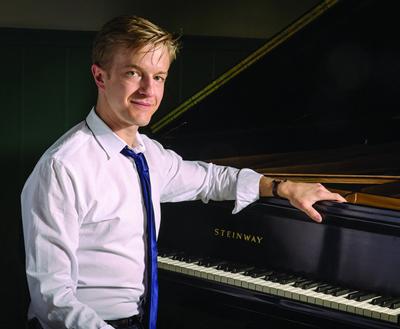by Daniel Hathaway

Associate conductor Levi Hammer was the superb soloist in Maurice Ravel’s Concerto in G, taking possession of its lively rhythms from the moment the piece was launched with that famous percussion slap. Playing with authority and a crystalline touch, Hammer was rock-steady but full of excitement in both the opening and closing movements, then turned utterly calm for the wonderful Adagio. Later, English hornist Cynthia Warren reprised the long, winding opening melody with elegant phrasing and gorgeous tone.
Wilkins and the orchestra were sharp but playful accomplices, especially in the opening movement, which featured a lovely harp interlude by Jody Guinn. Expert wind solos abounded and the clarinets (both B-flat and the impertinent E-flat model) distinguished themselves in the finale. This concerto is notorious for never making it through a live performance with all its details intact, but Hammer and the ASO came close. Springing off the piano bench at the end to an enthusiastic ovation, Levi Hammer returned to give the audience a calm, measured performance of William Bolcom’s Graceful Ghost Rag as an encore.
Wilkins opened the program with Mozart’s thirty-fourth symphony. Played with clarity and transparency, the symphony functioned as something of an overture to the Ravel. The winds were lovely and the violins energetic though a bit scrappy in fast passages.
Soloists Susan Fletcher, Amy Yekel, Alec Carlson and Adam Cioffari joined the Akron Symphony Chorus, prepared by Maria Sensi Sellner, for Mozart’s Mass in C, K. 317 to conclude the program. Mozart’s difficult boss, Cardinal Colloredo, liked his masses to last forty-five minutes, so this one, celebrating the appearance of the crowned Virgin Mary near Salzburg, was resplendent but typically efficient.
Having warmed up with Fauré’s beautifully lyric Pavane — most often performed without its optional chorus parts — the Akron Symphony Chorus gave a bright, alert account of the Mass, alternating with the well-blended solo quartet. Susan Fletcher brought an appropriately operatic style to her solos in the Agnus Dei.
It’s time for the annual rant about the acoustics of E.J. Thomas Hall — or at least time to record the earnest wish that the Akron Symphony could find a performing space that matches its high quality of music-making. From the audience, everything in EJT sounds as though it’s being filtered through layers of gauze, and you can only wonder what the musicians are hearing of each other onstage. Alternative seating arrangements have improved things to some extent in the past. Perhaps moving the winds closer to the piano for tonight’s Ravel concerto might have made things easier for everyone, but a long-term solution should be somewhere in the works.
Published on ClevelandClassical.com November 25, 2014.
Click here for a printable copy of this article



